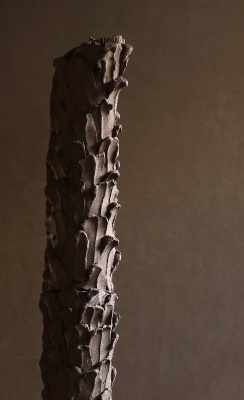Descripción de la Exposición
Rope, thread, cord, hemp, string, tape, pins, paint, and fabric. Formed by flexible materials, the works in Soft Power derive their presence and power from, on the one hand, the seductive qualities of fiber and fabric, and on the other, their social and cultural connotations. The multigenerational group of artists represented in this display employ softness as a physical fact and as a metaphor for the body. Often, they appropriate clothing, objects from popular culture, and other everyday materials we bring close to ourselves. Traditional dichotomies—inside and outside, surface and depth, protection and exposure—dissolve in each work as it conjures the human body through layers of material and suggestive forms.
Two works from the early 1970s explore the pliant potential of rope and its knotting. Françoise Grossen’s Inchworm, 1971, and Robert Rohm’s Untitled, 1970, were both made in dialogue with the prevailing attitudes and agendas of postminimalist sculpture. The late 1960s and early ’70s saw a number of artists pushing beyond the cohesive, reduced forms and industrial fabrication of minimalism to explore the behaviors of material processes, frequently through repeated gestures and actions. Artists experimented with hanging, dropping, stacking, draping, pulling, and pushing. And they did so with a range of materials, using metals, felt, glass, latex, earth, plastic, and fabric. By exploring the sheer weight of rope and its response to gravity, Grossen aligned her work with broader contemporary debates. The insistently horizontal Inchworm suggests a splayed body and avant-garde dance practices, which during this period were moving from the stage to the floor, as well as contemporaneous installations of scattered scraps of industrial felt and thread.
Robert Rohm began his knotted, stained, netlike structures by nailing them directly on the gallery wall. He then performed a sequence of simple, minimal interventions, such as cutting, that drastically altered the appearance of the grids. The process created a tension between rationality and randomness: after the grid’s connections were severed, its organized, geometric pattern devolved into disarray, illustrating the law of entropy that preoccupied many American artists during the 1970s.
While rooted in a discourse on procedural experimentation, the metaphorical, symbolic, and political possibilities of postminimalist sculpture’s material and process are consistently present. The placement of objects directly on the floor and wall, without a pedestal or other support, reflects widespread distrust in systems of display and authority. The often-violent actions visited on raw materials evoke the trauma of lived experience and larger social strife still relevant today. The legacy of these material metaphors informs the distinctive, socially conscious works by the younger artists represented in the current presentation. Material metaphor is joined by the specific cultural associations that arise from clothing and the domestic uses of fabric.
A group of floor-bound works occupy the center of the presentation, standing—and standing in for—the human body. Charles LeDray’s Untitled, 1992, is a painstakingly precise patchwork of denim and other cloth samples that covers a childlike form huddled in its sea of blues. Alexandre da Cunha appropriates a very different fiber in his BUST XXXV, 2012, upending a mop to create a figure immobilized in concrete, an idiosyncratic abstraction haunted by the evocation of labor performed to maintain institutional cleanliness. The figure is more explicitly present in Nick Cave’s Soundsuit, a life-size male mannequin body exquisitely clothed in a latticework of ornamented crochet, celebrating a seemingly humble craft with a skin bursting with optical energy. In lieu of a head, Cave’s costume-sculpture is topped by an orbiting chandelier-like nest of birds.
The combination of repetitive labor and domestic accessory also informs Alghierro Boetti’s Oggi il settimo giorno del settimo mese dell’ anno millenovecento ottantotto … per Giampaolo Prearo editore, 1988, a woven work presented in the format of a painting. To realize the work, Boetti outsourced production to craftspeople in Afghanistan, whom he engaged in an ongoing conversation. This cultural exchange between East and West brought conceptualism’s use of language as material together with the long Afghan tradition of weaving political imagery. Kai Altoff’s Untitled, 2004, made nearly thirty years later, depicts a skateboarder caught in mid-air within a field of luminous orange, the image painted on a striped fabric support. Here, traditional painting’s almost hidden identity as textile art is laid bare: the support for the image could be clothing, wallpaper, or drapery.
Rejecting the authority of the wall as well as painting’s uppermost perch in the received hierarchy of media, in Untitled, 2009, Josh Faught combines a contemporary appropriation of pop cultural references with postminimalism’s ideological understanding of space and material. For Faught, abstraction and activism are not mutually exclusive. He describes his artistic process as “constantly jamming together material histories until they become simultaneously abstract and narrative,” letting all the gendered, sexual, and cultural connotations of crocheting, sequins, and hemp hang together in a fiber work that, wrapped around a wooden frame, stands and leans, soft and hard.
—Dan Byers, Mannion Family Senior Curator

Exposición. 17 abr de 2025 - 03 sep de 2025 / Centro Cultural Andratx (CCA) / Andratx, Baleares, España

Formación. 08 may de 2025 - 17 may de 2025 / Museo Nacional Centro de Arte Reina Sofía (MNCARS) / Madrid, España